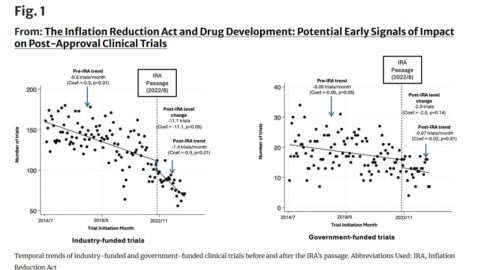I often act all exasperated when data emerges that shows that the net prices of medicines are going down, feigning frustration at the fact that there has been limited recognition of a truly astonishing trend toward lower prices.
But the truth is that I love those data points … exactly because there is so little attention to the issue. Every time another organization notes the drop in net prices, it’s another opportunity to educate.
So, anyway: SSR Health dropped their brief, quarterly look at net prices, and — sure enough — net was down 2.8% in the fourth quarter of 2023. That makes for 20+ consecutive quarters where net prices fell, and the 2.8% drop was the largest ever recorded by SSR. The difference between gross and net prices, unsurprisingly, rose as well. That hit its highest-ever level: 52.4%.
There are some specific dynamics at play here, notably Humira biosimilars, but there’s no question about the trend.
Net prices are falling. And Generalissimo Francisco Franco is still dead.
There is a lot of attention being paid to this new paper that suggests that it costs somewhere between 75 cents and $72 a month to make GLP-1 meds and that, therefore, they should be a lot cheaper.
It’s an argument that Bernie Sanders immediately seized upon. He has a release out calling for the GLP-1 makes to cut their prices closer to levels seen elsewhere in the world.
I’m going to assume good faith on the part of the paper’s authors — led by folks from Médecins Sans Frontières — who were, I think, making a broad point about the economics of getting these medicines into lower-income countries.
As for Sanders? Well, Bernie’s gonna Bernie.
But the applicability of work like this to the United States is, or ought to be, pretty close to nil. Brand-name drugs in this country aren’t priced according to the cost of goods. They’re priced according to the value they deliver and the expensive system by which innovation is fostered. That’s not a radical concept. It’s literally the foundation of the U.S. system. The theory is even baked into the IRA, flawed as that law may be.
So there is some small amount of frustration in seeing COGS presented as if it should have a meaningful impact on the discussion around how medicines are priced.
Another vote in favor of fixing the IRA’s “pill penalty” through the EPIC Act, this time via an op-ed from longtime DC health policy fixture Dan Leonard.
I generally believe, when it comes to gene therapy, it’s worth paying attention to just about everything that Courtney Rice says. So I was excited to see Courtney — along with Tom McDonnell from BW Health Group and Frameshift’s Ben Tempel — in this MM&M piece about gene therapy launches.
If this email was forwarded to you, and you’d like to become a reader, click here to see back issues of Cost Curve and subscribe to the newsletter.





